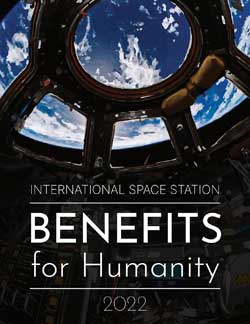
HOUSTON (NASA PR) — The 2022 edition of the International Space Station Benefits for Humanity publication is now available. This updated edition is packed with numerous benefits of the microgravity laboratory highlighting groundbreaking discoveries helping society, technologies tested for future space exploration, new scientific breakthroughs, and contributions to the growing low-Earth orbit (LEO) economy.
Over more than two decades, the International Space Station has evolved into an advanced microgravity laboratory for human space operations and science. The space station offers researchers worldwide the opportunity to utilize the unique environmental conditions of LEO, supporting hundreds of experiments across every major scientific field at any given time. With over 20 years of research and 3,300 experiments hosted aboard the station, now more than ever discoveries and developments are taking shape. The station’s ability to foster research has aided in the growing commercial space economy allowing new players to enter the space marketplace and launching flourishing businesses back on Earth.
“This edition focuses on new areas of scientific study that are resulting from the last two decades of ISS research, future technologies for the exploration of the Moon and Mars, lifesaving discoveries, and the companies and economic benefits enabled by this research.” said Dr. Kirt Costello, chief scientist for the space station at NASA’s Johnson Space Center in Houston.
Some of the benefits featured in this edition include how:
- Advances in X-ray technologies that were developed to create NICER, a space station telescope, are helping unravel the mysteries of our universe while improving medical devices on Earth.
- Drugs, cancer treatment strategies, and artificial blood developed from protein crystal growth studies aboard station are improving human and animal health.
- Data from NASA’s ECOSTRESS payload has been employed in efforts to reduce heat absorbed by city surfaces, reduce fire risk, and help farmers efficiently water their fields.
- Station is inspiring the next generation of scientists by providing opportunities to conduct meaningful studies on topics such as DNA sequencing, robotics, and satellites in orbit.
- The orbiting laboratory is advancing the field of in-space manufacturing, from 3D printed human tissue to optical fibers for communication.
In addition to the print publication, this year’s release includes videos, podcasts, and digital features that dive deeper into some of the issue’s stories.
The ISS Benefits for Humanity 2022 is a product of the International Space Station Program Science Forum (PSF), which includes the National Aeronautics and Space Administration (NASA), Canadian Space Agency (CSA), European Space Agency (ESA), Japan Aerospace Exploration Agency (JAXA), State Space Corporation ROSCOSMOS (ROSCOSMOS), and the Italian Space Agency (ASI). Although each of the International Space Station partners have individual research goals, the partnership strides together to propel humanity forward through scientific inquiry and investigation.
“The research done on the International Space Station advances scientific understanding of our planet, improves human health, develops cutting-edge technologies, and inspires and educates the leaders of tomorrow through its successful international partnerships; a truly exciting mission and part of a legacy that will be felt for decades to come,” said Costello.
View the full Benefits for Humanity 2022 publication here:
- Feature articles, videos, podcasts: www.nasa.gov/stationbenefits
- Full digital book in PDF format
- Kindle readers: MOBI format (coming soon)
- All other eBook readers: EPUB format (coming soon)
Additional information:
- Find more information about the space station’s benefits for humanity here.
- View the International Space Station Annual Research Highlights report for info on the latest station results.
- Follow updates about the science conducted aboard the space station on Twitter @ISS_Research.
- Keep up to date with the latest in station science news by signing up for our newsletter.
- For more information about conducting research in microgravity, visit: www.nasa.gov/iss-science
- To learn about opportunities for sending your project ideas to space station, visit: www.nasa.gov/stationopportunities

